基因工程基本操作的四个步骤
- 格式:ppt
- 大小:1.56 MB
- 文档页数:13
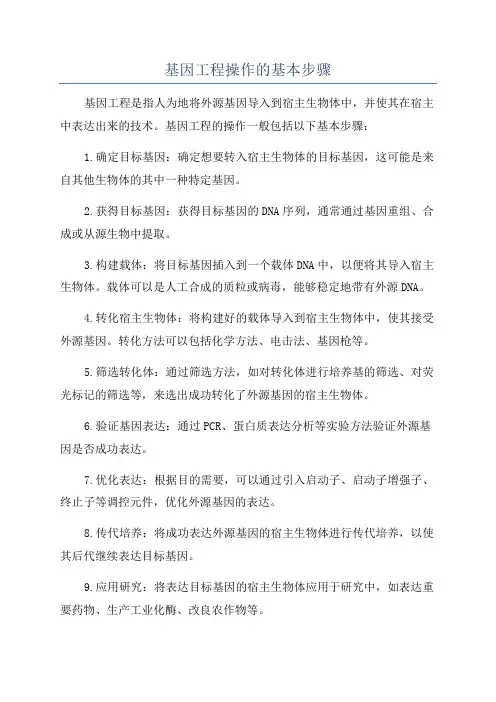
基因工程操作的基本步骤
基因工程是指人为地将外源基因导入到宿主生物体中,并使其在宿主中表达出来的技术。
基因工程的操作一般包括以下基本步骤:
1.确定目标基因:确定想要转入宿主生物体的目标基因,这可能是来自其他生物体的其中一种特定基因。
2.获得目标基因:获得目标基因的DNA序列,通常通过基因重组、合成或从源生物中提取。
3.构建载体:将目标基因插入到一个载体DNA中,以便将其导入宿主生物体。
载体可以是人工合成的质粒或病毒,能够稳定地带有外源DNA。
4.转化宿主生物体:将构建好的载体导入到宿主生物体中,使其接受外源基因。
转化方法可以包括化学方法、电击法、基因枪等。
5.筛选转化体:通过筛选方法,如对转化体进行培养基的筛选、对荧光标记的筛选等,来选出成功转化了外源基因的宿主生物体。
6.验证基因表达:通过PCR、蛋白质表达分析等实验方法验证外源基因是否成功表达。
7.优化表达:根据目的需要,可以通过引入启动子、启动子增强子、终止子等调控元件,优化外源基因的表达。
8.传代培养:将成功表达外源基因的宿主生物体进行传代培养,以使其后代继续表达目标基因。
9.应用研究:将表达目标基因的宿主生物体应用于研究中,如表达重要药物、生产工业化酶、改良农作物等。

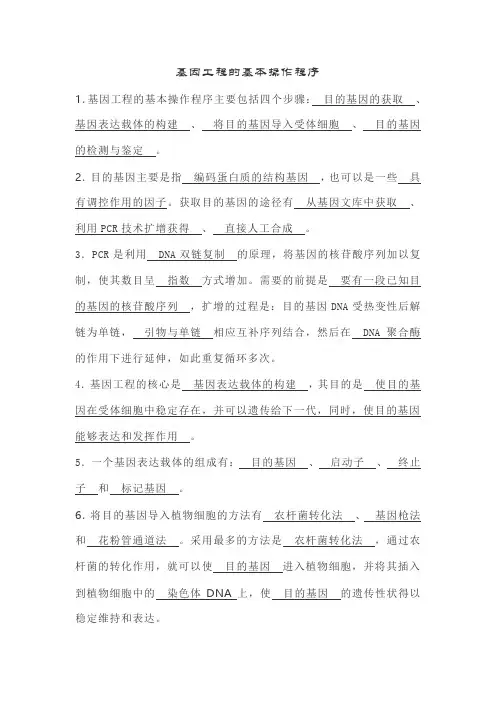
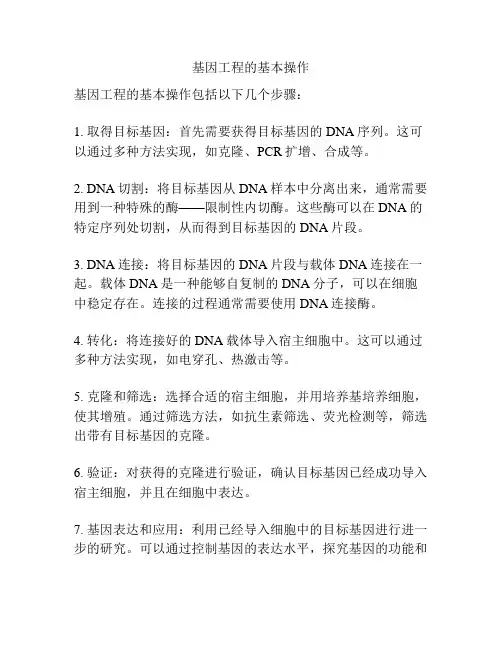
基因工程的基本操作
基因工程的基本操作包括以下几个步骤:
1. 取得目标基因:首先需要获得目标基因的DNA序列。
这可以通过多种方法实现,如克隆、PCR扩增、合成等。
2. DNA切割:将目标基因从DNA样本中分离出来,通常需要用到一种特殊的酶——限制性内切酶。
这些酶可以在DNA的特定序列处切割,从而得到目标基因的DNA片段。
3. DNA连接:将目标基因的DNA片段与载体DNA连接在一起。
载体DNA是一种能够自复制的DNA分子,可以在细胞中稳定存在。
连接的过程通常需要使用DNA连接酶。
4. 转化:将连接好的DNA载体导入宿主细胞中。
这可以通过多种方法实现,如电穿孔、热激击等。
5. 克隆和筛选:选择合适的宿主细胞,并用培养基培养细胞,使其增殖。
通过筛选方法,如抗生素筛选、荧光检测等,筛选出带有目标基因的克隆。
6. 验证:对获得的克隆进行验证,确认目标基因已经成功导入宿主细胞,并且在细胞中表达。
7. 基因表达和应用:利用已经导入细胞中的目标基因进行进一步的研究。
可以通过控制基因的表达水平,探究基因的功能和
调控机制。
同时,还可以利用基因工程技术将目标基因导入其他生物体,实现特定性状的改良和应用。

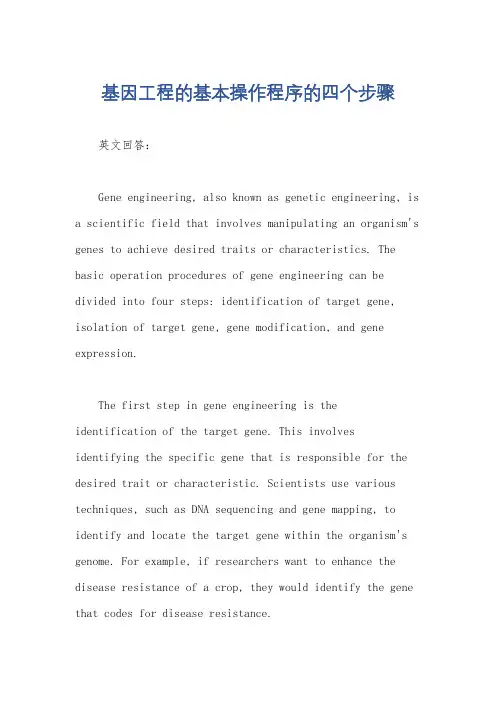
基因工程的基本操作程序的四个步骤英文回答:Gene engineering, also known as genetic engineering, is a scientific field that involves manipulating an organism's genes to achieve desired traits or characteristics. The basic operation procedures of gene engineering can be divided into four steps: identification of target gene, isolation of target gene, gene modification, and gene expression.The first step in gene engineering is theidentification of the target gene. This involvesidentifying the specific gene that is responsible for the desired trait or characteristic. Scientists use various techniques, such as DNA sequencing and gene mapping, to identify and locate the target gene within the organism's genome. For example, if researchers want to enhance the disease resistance of a crop, they would identify the gene that codes for disease resistance.Once the target gene has been identified, the next step is to isolate it from the organism's genome. This is done through a process called gene isolation. Scientists use enzymes, such as restriction enzymes, to cut the DNA at specific points and isolate the target gene. The isolated gene is then purified and prepared for further manipulation. For instance, if the target gene is responsible for producing a specific protein, scientists would isolate the gene coding for that protein.After the target gene has been isolated, the next stepis gene modification. This involves altering the targetgene to introduce desired changes or traits. Scientists can use various techniques, such as gene splicing or gene synthesis, to modify the gene. Gene splicing involvescutting the target gene and inserting new DNA sequences, while gene synthesis involves creating an entirely new gene from scratch. For example, if scientists want to create a genetically modified organism that produces a higher yieldof a particular crop, they would modify the target gene responsible for crop yield.The final step in gene engineering is gene expression. This step involves introducing the modified gene into the target organism and ensuring that it is expressed or activated. Scientists use techniques such as gene delivery systems or gene transfer to introduce the modified geneinto the organism's cells. Once inside the cells, the modified gene is integrated into the organism's genome and starts producing the desired trait or characteristic. For instance, if scientists have modified a gene to produce a specific enzyme in a bacteria, they would introduce the modified gene into the bacteria and ensure that the enzymeis expressed and produced.中文回答:基因工程,也被称为遗传工程,是一门涉及操纵生物体基因以实现所需特征或特性的科学领域。
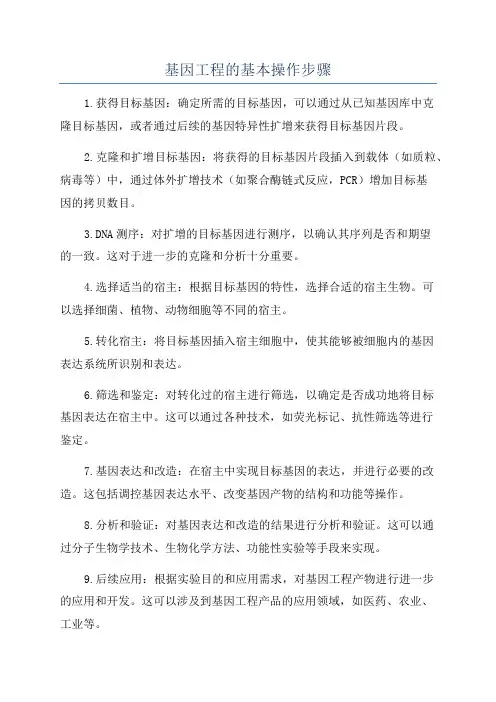
基因工程的基本操作步骤1.获得目标基因:确定所需的目标基因,可以通过从已知基因库中克隆目标基因,或者通过后续的基因特异性扩增来获得目标基因片段。
2.克隆和扩增目标基因:将获得的目标基因片段插入到载体(如质粒、病毒等)中,通过体外扩增技术(如聚合酶链式反应,PCR)增加目标基因的拷贝数目。
3.DNA测序:对扩增的目标基因进行测序,以确认其序列是否和期望的一致。
这对于进一步的克隆和分析十分重要。
4.选择适当的宿主:根据目标基因的特性,选择合适的宿主生物。
可以选择细菌、植物、动物细胞等不同的宿主。
5.转化宿主:将目标基因插入宿主细胞中,使其能够被细胞内的基因表达系统所识别和表达。
6.筛选和鉴定:对转化过的宿主进行筛选,以确定是否成功地将目标基因表达在宿主中。
这可以通过各种技术,如荧光标记、抗性筛选等进行鉴定。
7.基因表达和改造:在宿主中实现目标基因的表达,并进行必要的改造。
这包括调控基因表达水平、改变基因产物的结构和功能等操作。
8.分析和验证:对基因表达和改造的结果进行分析和验证。
这可以通过分子生物学技术、生物化学方法、功能性实验等手段来实现。
9.后续应用:根据实验目的和应用需求,对基因工程产物进行进一步的应用和开发。
这可以涉及到基因工程产品的应用领域,如医药、农业、工业等。
除了上述的基本操作步骤,基因工程还需要进行严格的实验设计、对操作过程进行质量控制和数据分析。
此外,基因工程的操作过程还需要遵守相关的伦理原则和法律法规,确保实验的安全性和合规性。
需要注意的是,基因工程是一个复杂的过程,具体的操作步骤可能因不同的实验目的、技术手段和宿主生物的选择而有所差异。
因此,在实际操作中,可能需要根据具体情况进行调整和优化。
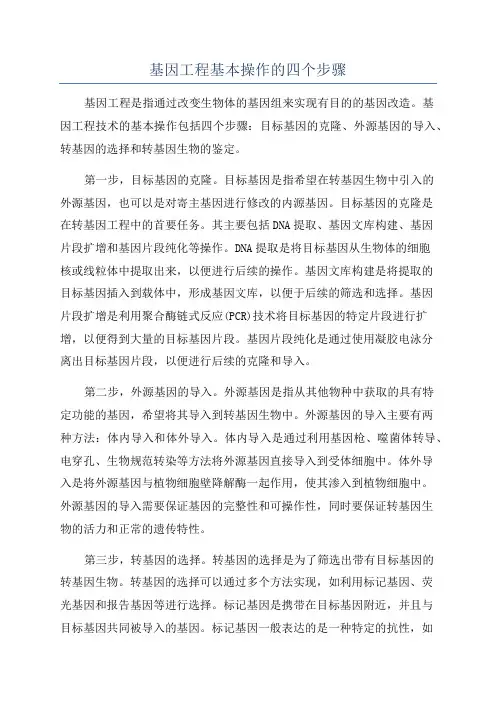
基因工程基本操作的四个步骤基因工程是指通过改变生物体的基因组来实现有目的的基因改造。
基因工程技术的基本操作包括四个步骤:目标基因的克隆、外源基因的导入、转基因的选择和转基因生物的鉴定。
第一步,目标基因的克隆。
目标基因是指希望在转基因生物中引入的外源基因,也可以是对寄主基因进行修改的内源基因。
目标基因的克隆是在转基因工程中的首要任务。
其主要包括DNA提取、基因文库构建、基因片段扩增和基因片段纯化等操作。
DNA提取是将目标基因从生物体的细胞核或线粒体中提取出来,以便进行后续的操作。
基因文库构建是将提取的目标基因插入到载体中,形成基因文库,以便于后续的筛选和选择。
基因片段扩增是利用聚合酶链式反应(PCR)技术将目标基因的特定片段进行扩增,以便得到大量的目标基因片段。
基因片段纯化是通过使用凝胶电泳分离出目标基因片段,以便进行后续的克隆和导入。
第二步,外源基因的导入。
外源基因是指从其他物种中获取的具有特定功能的基因,希望将其导入到转基因生物中。
外源基因的导入主要有两种方法:体内导入和体外导入。
体内导入是通过利用基因枪、噬菌体转导、电穿孔、生物规范转染等方法将外源基因直接导入到受体细胞中。
体外导入是将外源基因与植物细胞壁降解酶一起作用,使其渗入到植物细胞中。
外源基因的导入需要保证基因的完整性和可操作性,同时要保证转基因生物的活力和正常的遗传特性。
第三步,转基因的选择。
转基因的选择是为了筛选出带有目标基因的转基因生物。
转基因的选择可以通过多个方法实现,如利用标记基因、荧光基因和报告基因等进行选择。
标记基因是携带在目标基因附近,并且与目标基因共同被导入的基因。
标记基因一般表达的是一种特定的抗性,如抗生素抗性或除草剂抗性。
通过在选择培养基中添加相应的抗生素或除草剂,可以筛选出带有目标基因的转基因生物。
荧光基因和报告基因是将目标基因与荧光蛋白或特定报告基因进行连接,通过检测荧光或特定指标的表达情况,可以筛选出带有目标基因的转基因生物。


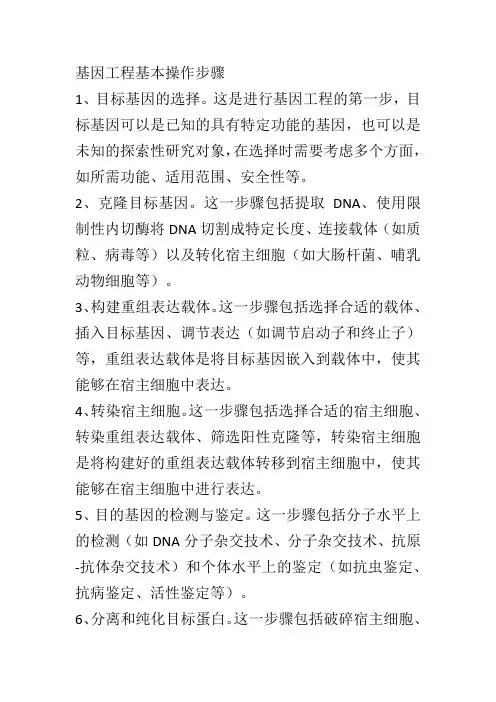
基因工程基本操作步骤
1、目标基因的选择。
这是进行基因工程的第一步,目标基因可以是已知的具有特定功能的基因,也可以是未知的探索性研究对象,在选择时需要考虑多个方面,如所需功能、适用范围、安全性等。
2、克隆目标基因。
这一步骤包括提取DNA、使用限制性内切酶将DNA切割成特定长度、连接载体(如质粒、病毒等)以及转化宿主细胞(如大肠杆菌、哺乳动物细胞等)。
3、构建重组表达载体。
这一步骤包括选择合适的载体、插入目标基因、调节表达(如调节启动子和终止子)等,重组表达载体是将目标基因嵌入到载体中,使其能够在宿主细胞中表达。
4、转染宿主细胞。
这一步骤包括选择合适的宿主细胞、转染重组表达载体、筛选阳性克隆等,转染宿主细胞是将构建好的重组表达载体转移到宿主细胞中,使其能够在宿主细胞中进行表达。
5、目的基因的检测与鉴定。
这一步骤包括分子水平上的检测(如DNA分子杂交技术、分子杂交技术、抗原-抗体杂交技术)和个体水平上的鉴定(如抗虫鉴定、抗病鉴定、活性鉴定等)。
6、分离和纯化目标蛋白。
这一步骤包括破碎宿主细胞、
使用不同的技术对混合物进行分离(如层析、电泳等)。
基因工程操作的基本步骤
1.目标选择:确定需要修改的目标基因和目标生物体。
目标基因是指
具有特定功能或性状的基因,目标生物体是指需要进行基因改造的生物体。
2.基因克隆:将目标基因从生物体中分离出来。
这通常是通过使用酶
切酶酶切DNA,然后使用聚合酶链反应(PCR)等技术复制目标基因。
3.基因载体构建:将目标基因插入到合适的基因载体中。
基因载体是
一种可以携带外源基因并将其稳定地转移到目标生物体中的分子。
常见的
基因载体包括质粒、噬菌体和人工染色体等。
4.转化:将构建好的基因载体转移给目标生物体。
转化可以通过物理
方法(如电穿孔、基因枪等)或化学方法(如钙磷共沉淀法、电渗法等)
进行。
5.筛选与鉴定:使用适当的筛选方法来确定是否成功转化目标生物体。
这通常涉及在转化后检测生物体中的目标基因或目标表型。
6.获得纯合系:当目标基因转移到目标生物体中后,需要经过繁殖和
筛选多代,以获得更稳定、纯合的基因型。
7.功能验证:对获得的转基因生物进行功能验证,确定目标基因是否
能够发挥预期的作用。
8.产业化应用:对功能验证通过的转基因生物进行进一步研究和开发,以满足具体的临床、农业或工业应用需求。
需要注意的是,基因工程操作需要严格依照伦理规范和法律法规进行,并进行充分的风险评估和安全措施,以确保操作的安全性和可行性。
3.2 基因工程的基本操作程序 教学目标教学重点1.基因工程基本操作程序的四个步骤。
2.DNA 片段的扩增及电泳鉴定。
教学难点1. 利用PCR 获取和扩增目的基因。
2. DNA 片段的扩增及电泳鉴定。
知识点01 第一步:目的基因的筛选与获取1.目的基因:在基因工程的设计和操作中,用于改变受体细胞性状或获得预期表达产物等的基因。
也指能够编码特定蛋白质的基因,也可以是一些具有调控作用课程标准目标解读 基因工程是一种重组DNA 技术。
1. 阐明基因工程的基本操作程序主要包括目的基因的获取、基因表达载体的构建、目的基因导入受体细胞和目的基因及其表达产物的检测鉴定等步骤。
1. 阐明基因工程的原理和基本操作程序。
2. 针对人类生产或生活中的某一需求,选取适当的基因工程的技术和方法,尝试设计获得某一转基因产品的方案。
3. 尝试进行PCR 的基本操作并用电泳鉴定PCR 的产物。
知识精讲目标导航的因子。
2.筛选目的基因:从相关的已知结构和功能清晰的基因中筛选,是较为有效的方法之一3.获取目的基因:(1)人工合成(2)基因文库中获取目的基因(3)利用PCR获取和扩增①PCR:PCR全称为聚合酶链式反应,又叫做体外DNA扩增技术。
根据DNA半保留复制的原理,在体外提供参与DNA复制的各种组分与反应条件,对目的基因的核苷酸序列进行大量复制的技术。
通过这项技术可在短时间内大量扩增目的基因。
②PCR利用的原理:DNA半保留复制③DNA复制的基本条件:④PCR的前提:有一段已知目的基因的核苷酸序列,以便根据这一序列合成引物。
⑤PCR的条件:DNA模板(需含有目的基因)。
分别与模板DNA相结合的2种引物。
四种脱氧核苷酸(或四种dNTP:dATP、dTTP、dGTP、dCTP)。
耐高温的DNA聚合酶(Taq酶)。
稳定的缓冲溶液(一般添加Mg2+)。
能严格控制温度的温控设备。
⑥PCR的过程:⑦PCR的结果:以指数方式扩增,即2n(n为扩增循环的次数)⑧鉴定PCR的产物:常采用琼脂糖凝胶电泳来鉴定产物知识点02 第二步:基因表达载体的构建基因表达载体的组成:目的基因、标记基因、启动子、终止子基因表达载体构建过程:一般用同一种限制酶分别切割载体和含有目的基因的DNA片段,再用DNA连接酶将两者连接。
基因工程的基本操作步骤4基因工程的基本操作步骤基因工程是一种将外源基因或人为改造的基因导入到生物体内,从而改变其遗传特性的技术。
作为一项复杂而关键的科学技术,基因工程需要遵循一系列基本操作步骤。
本文将介绍基因工程的基本操作步骤,帮助读者了解和理解这一领域的基础知识。
1. 提取目标基因基因工程的第一步是提取目标基因。
目标基因可以来自不同生物体的DNA,包括细菌、植物、动物等。
提取目标基因需要使用特定的提取方法,例如PCR(聚合酶链式反应)技术。
在这一步骤中,需要具备实验室操作技能,同时需遵守实验室安全操作规范。
2. 构建基因载体在基因工程中,基因载体扮演着非常重要的角色。
基因载体是将目标基因导入宿主细胞的工具,通常是由DNA分子构成。
基因载体的构建需要选择适当的载体类型,并将目标基因与载体连接起来。
常见的基因载体包括质粒、病毒等,其构建过程需要遵循相关实验技术和原则。
3. 转化宿主细胞一旦基因载体构建完成,下一步是将其导入宿主细胞中。
这个过程被称为转化。
转化可以通过多种方法实现,例如热激冲击、化学处理或电击。
通过转化,基因载体得以进入宿主细胞,并将目标基因在宿主细胞内表达。
4. 鉴定转化细胞经过转化后,不是所有的细胞都成功地接受了目标基因。
因此,鉴定转化的细胞是基因工程中一个关键的步骤。
鉴定的方法通常基于目标基因在细胞中的表达,可以通过PCR扩增、酶切或荧光显微镜观察等实验手段来进行。
5. 培养和筛选鉴定成功的转化细胞后,需要对其进行培养和筛选。
在培养基中,细胞会持续生长和分裂,并表达目标基因。
为了筛选出带有目标基因的细胞,通常需要加入适当的筛选剂或标记基因。
通过培养和筛选,可以获得大量带有目标基因的细胞。
6. 分离纯化在获得带有目标基因的细胞后,接下来的步骤是分离和纯化目标基因。
这可以通过一系列的实验方法实现,如凝胶电泳、离心、柱层析等。
分离纯化后的目标基因可用于进一步的研究或应用。
总结:基因工程的基本操作步骤包括提取目标基因、构建基因载体、转化宿主细胞、鉴定转化细胞、培养和筛选、以及分离纯化。